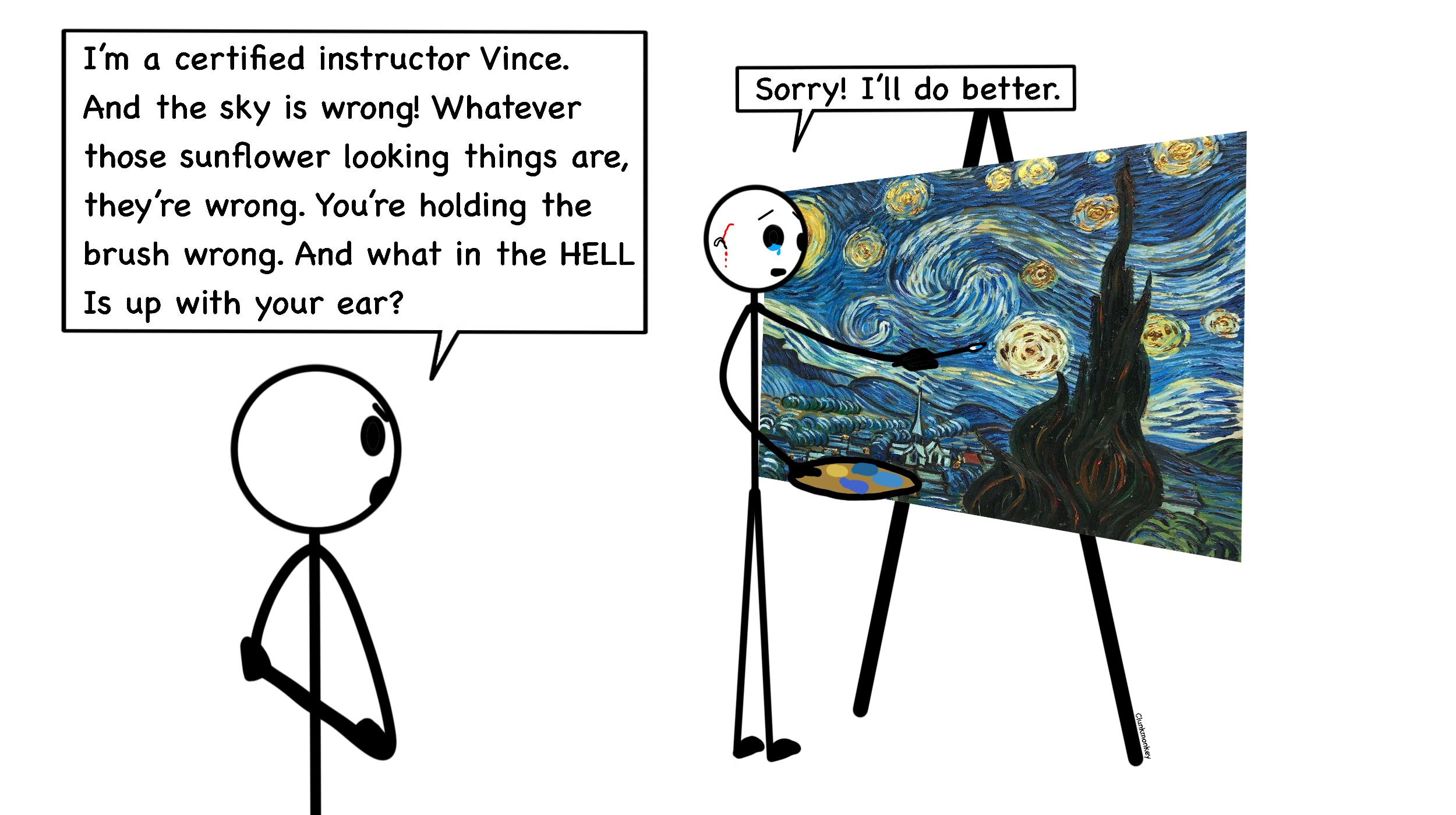Football players lined up on a pitch, the crucible of little orange cones in front of them; A tennis player pulls her magic wand from its bag and steps onto the court for a lesson; Professional type people attend lectures at a success seminar. A smiley faced name tag pinned to every lapel. Hi, I’m Bob, and today is the first day of the rest of my life.
They are all where they are for the same reason: Because people need to be taught. There are ‘right’ and ‘wrong’ ways of doing things, and left alone… we’ll learn the wrong one.
Or… so the story goes.
It’s a story plays out favorably for teachers. Because teaching creates dependence.
Here. I’ll show you.
A student asks a teacher how to do a thing… let’s say how to hit a tennis serve into the box. The teacher gives them explicit instruction. You know… feet here, elbow there stuff.
What is the first question that’s ALWAYS asked by that student after they do it?
“Did I do it right?”
The serve going in the box (what they asked about) is now less important than doing it the “right” way. (Most will never outgrow this dependency. If you doubt that, let me remind you that professional players… the elite of the elite, still take lessons.)
Wherever there are teachers, there are agencies dedicated to determining ‘best practices’ and standardizing what is being taught. (For the customers sake, and a fee… of course.)
This is why Socrates worried about teaching becoming a formal profession.
And while it’s nice to know that those agencies are “looking out for us”. Let’s not forget that certifying instructors is one hell of a lucrative business. It also creates a potential conflict of interest. (When ones professional status depends on an organization… it’s pretty easy to figure out where their loyalties lie.)
Do you really think your coach will resign their “master coach” certification upon discovering that people don’t need to be taught?
Another problem with all this teaching… the result of a bunch of people being taught standardized information is conformity.
Fifty years ago professional tennis displayed a tremendous variety of styles of play. Pancho Gonzales, Bjorn Borg, Ramesh Krishnan, Jimmy Connors, Chris Evert, Steffi Graf, Ilie Nastase, Martina Navratilova, John McEnroe… but a few of the many artists who brought their insight to the game.
And this creative diversity regularly made for spectacular spontaneous art. Which in turn made the game incredibly popular.
The popularity lead to lots of instruction. Lots of instruction led to standardized methods, and techniques; Led to sports academies; And a couple decades of those bring us to today’s game. Pure athleticism displayed through a monotony of technique.
And this history of conformity radiates out into every sport and cascades down through every level of play.
But I didn’t invite you here to lament the current lack of artistry professional sport. My interest lies in the True cost of instruction. Because what few ever talk about is what sport really is… a vehicle for self-understanding.
And instruction intentionally short circuits that. It’s true. The most important aspect of sport is attenuated… and for what?
In 28 years of coaching, I have never met someone who needed to be taught. That is to say a person whose natural inclination was to learn ‘wrong’. And I don’t think I’ve ever met someone who is “talented” either. These are sacred myths that we created to preserve the temple of our profession.
That’s the dark secret behind standardized fundamentals and uniform instruction and drills and the rest of the coaching religion.
There isn’t a right way to play… there are as many ways as there are players. And no one needs instructors to help them find theirs – they probably guarantee we won’t.
The funny thing about all this is that if I were to conduct instruction by throwing a ball out on the field… or putting a racket in your hand, and telling you to go figure it out, you would ask for a refund.
Even though I just gave you the best advice money can buy.

